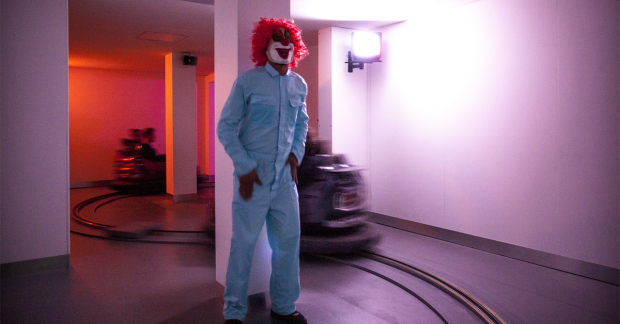PHOBIARAMA say the blinking circus-tent letters on an otherwise plain black pop-up cube in Granary Square, dwarfed by the much larger, calmer, Waitrose sign, under which one goes to get pre-sliced comfort food. It’s a fitting spatial intervention for Phobiarama, Dutch visual artist Dries Verhoeven’s latest installation-performance to be presented at LIFT; the piece, as its title would suggest, plumbs the portmanteau of irrational fear and spectacle present in the carnival tradition of horror/funhouse, a controlled space where people pay to feel ill at ease, also known as an ‘attraction’. Verhoeven offers us a reminiscent, if not exactly nostalgic, ghost train ride to explore the co-operations of fear, entertainment, mediation and manipulation. All populist – sorry, popular – stuff: in the absence of a crier shouting ‘roll up, roll up’ there’s already a healthy queue in the square.
Any forms of sustenance you might have just bought – along with keys, money, phone, the materials of security, identity, and connection – are checked at the door, at the smiling suggestion of people in festival badges. You are given a door number and fumble down a narrow, pitch-black corridor. Behind the door a two-person fun car is perched on a meandering track, waiting. There is no longer anyone to give instructions; as in a dream, there is only one thing to do: get in, primed for vertigo, and wait. There is no seat belt or steering wheel.
The ghost train lurches into action, slowly at first, carrying you through darkness punctured by abstract emanations from TV screens mounted in the corners, curving in loops around a succession of strangely configured rooms and columns, to a soundscape of thick drone; on the telly, a verbal overlay of fuzzy news and political rhetoric. Lights turn on and off unsettlingly, irregularly. You catch the image of a figure in the corridor.
The interplay between the kind of visceral fear one might experience when, say, confronted by a bear, and the sort of cortisol-raising stress about news-story dangers, like immigration, or microplastics, is there to explore as the trolleys speed up; Nigel Farage’s voice booms from the corner; and the space fills gradually with bears. Tall, furry, lumbering creatures in any case, in a dream where you can’t be sure, or see things directly. They lurk around bends, behind columns, approach in a kind of clockwork choreography: the moment of threat feels unnaturally distended, but then your car slides away at the slow-motion last minute.
In the next part the bears undress, momentarily assuming human movement to remove their, okay, costumes. Whew! Oh. Now they are clowns, dancing with creepy hip gyrations, climbing on the back of the cars in a mechanical, wind-up toy sort of way. The clown in front of you pulls off his mask, to reveal the naked face of a man, staring directly at you. He strips down to red boxer briefs, folds up the clown suit neatly and goes into the shadows.
What seems like a checklist of phobias (where are the spiders?), performed as a show; I think is supposed to work as an excavation. Or is it? On the CCTV, placed conveniently right beside the smoke detector (ones you get on unclutterer), you see all the performers at once striding as a gang – each and every one of them tall, built, muscled, tattooed, straight out of a TV prison show. The monitor shows passengers being stopped and interrogated, and then led away. There are muffled sounds of screaming.
The burly men continue to stride around, half-naked, staring at you mutely. They might come after you. They might not. Now the visceral sense is back – not a fear itself; you haven’t fully suspended the fact that at the end of the day you’re at a Dutch art thing next to the Waitrose. Stripping back further layers as the lights come on, you feel these men not as menacing criminals but chosen specimens in a show, bodies on display. What if they could shed their muscle suits too? It’s true that you don’t see bodies like this in one place everyday (note: you should go to the gym more) – but are you ‘supposed’ to be afraid here? Would you clutch your purse, if it weren’t already in their hands?
The installation artist exploring fear as a concept does not enter into the same contract as the funhouse operator promising to induce it, but Phobiarama manages to do pretty well with both.

